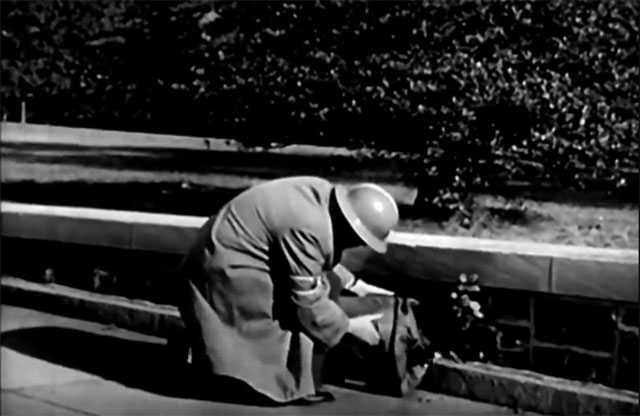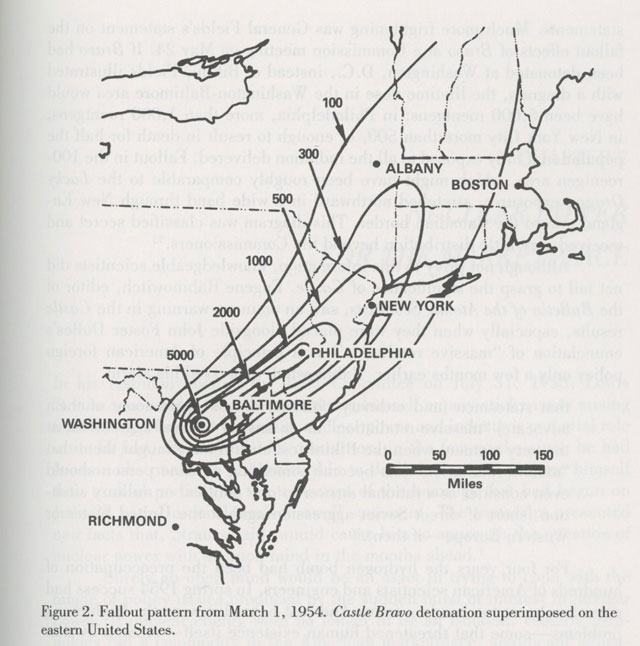
Current fears of the potential use of nuclear weapons — partly resulting from the North Korean weapon program and accompanying threats by President Trump, and mishaps like the errant ballistic missile alert notification in Hawaii recently — have led to a new flush of articles on what to do if there is a nuclear weapon detonation nearby. Articles, such as “What to do in case of a nuclear attack,” in the Washington Post, and “How to survive a missile attack: What’s the official advice?” on the BBC website, offer thoughtful and pragmatic guidance to those who are anxious about protecting themselves and their families under atomic attack.
These articles offer sage tips, such as “get inside, stay inside, stay tuned,” or as it is referred to: shelter in place. An article in the Dallas Morning News advises, “If you’re outside and can’t get inside within a few minutes, lie on the ground and cover your head. Take cover behind anything that could offer some protection.” The BBC article offers guidance mined from the website of the US Department of Homeland Security — “An underground area such as a home or office building basement offers more protection than the first floor of a building. The heavier and denser the materials — thick walls, concrete, bricks, books and earth — between you and the fallout particles, the better.”
News articles such as these fill a need in an anxious public longing to feel as though there are actions that they can take to mitigate the effects of a nuclear attack, and procedures that will minimize the effects of radiation. As a historian working on nuclear issues and living and teaching in Hiroshima, such discourse is not only familiar, but also plays a dangerous role in the national conversation. Articles such as these seemingly well-intentioned advice columns for the apocalypse normalize the use of nuclear weapons: They depict nuclear attacks as events in which we will have agency and the capacity to respond to in meaningful ways.
I am reminded of the responses of my students here in Hiroshima whenever I show them the 1951 Civil Defense film classic, Duck and Cover. While many Westerners remember this film for its campy opening animation sequence, what astonishes my students is the later sections that communicated to children what to do if there was a nuclear attack. In this section, you see children responding to the bright, white flash of a nuclear detonation by taking steps to protect themselves. They duck under their bus seats, they run behind buildings, they get off their bicycles and lie down against a curb. At a family picnic, a father is seen putting a newspaper over his head as he dives to the ground. My students are stunned, many offering involuntary laughter at the scenes. The reason they are so shocked is that they have grown up with a far more intimate understanding of what happens when a nuclear weapon detonates. Many have personal, familial histories of the loss of ancestors; many have hibakusha, or survivors, in their families. The stories of what followed the bright, white flash on that August Monday morning come from experience and not from hope. All have been raised with an education that stresses what actually happened in Hiroshima. The notion that anyone would have had the time to “react” to the flash, and to engage in a course of actions that might mitigate the arrival of the bomb’s effects, is ludicrous to them. They understand that the blast and heat that accompanied the detonation arrived less than a second after the flash, as did the burst of gamma radiation that killed tens of thousands within a week or two. No amount of training or preparation would have helped.
Beyond the immediate reaction to a detonation, even having some time — as those terrified people in Hawaii had before the imagined impact of the incoming ballistic missiles — the notion that preparations, actions and reactions, would accomplish much is mostly illusory. Yes, being indoors would be better than being outdoors, given you are a sufficient distance from the detonation. But it would be better by degrees and not magnitudes. If you are in the radius of the blast and heat of the weapons, buildings may not offer sufficient shelter, as most will collapse and the contents inside of even brick buildings may instantly catch fire from the heat. It would rarely make the difference between avoiding disaster and being immersed in disaster.
But one of the other insidious things that articles like this do, is to suggest that the period after a nuclear attack would be one of rational choices and measured activities. The article in the Dallas Morning News advises, “If you are outside during a blast, wash yourself off as soon as possible, removing clothes that could have radioactive material on them and keeping them far away from other people or animals to avoid contamination. Take a shower with lots of soap and water, washing your hair with shampoo or soap but not conditioner (which could bind radioactive material to your hair and make it tough to wash out).”
There is a lot to unpack here. After a nuclear attack, the suggestion that one can go somewhere and find clean, running water is ridiculous. Or that one could take their contaminated clothes off and simply find uncontaminated clothes nearby. Or that washing your hair one time will remove the systemic dangers of being in a radiologically contaminated environment, and your hair would not simply reabsorb some of that radiation. Or that shampoo would be uncontaminated, etc. This is a vision of a post-nuclear environment in which the conditions prior to the attack would quickly and easily be restored, and an ordered society would be available to everyone that “survives” the detonation.
What will it be like after a nuclear attack? Just think of the current situation in Puerto Rico to get a sense of the difficulties of restoring order after a natural disaster. Add to that the panic and anxiety of dwelling in a contaminated place, full of the dead and the dying, where responders would be cautious to enter, and you barely begin to understand that the horrors have only begun once the blast is over. Harkening back to that primary text of Duck and Cover, I am reminded of what happens to little Tony after he dives from his bicycle to take shelter against the curb when there is a nuclear detonation — he remains there even after the explosion. The narrator advises us that “Tony knew what to do. Notice how he keeps from moving, or getting up and running? He stays down until he is sure the danger is over.” A man walks into the scene and helps Tony get up, “The man helping Tony is a Civil Defense worker. His job is to help protect us when there is danger of the atomic bomb. We must obey the Civil Defense worker.”
 The “Civil Defense worker” helps Tony recover after the nuclear detonation in Duck and Cover (1951).
The “Civil Defense worker” helps Tony recover after the nuclear detonation in Duck and Cover (1951).
This fallacy remains at the heart of our “preparations”: The notion that order will swiftly follow a nuclear attack. For Tony, a Civil Defense worker was, apparently, about 20 feet away at the time of the attack, and he quickly came specifically to Tony to let him know that he could now proceed with his childhood. All was in order. For us, it means that we can quickly wash our hair with shampoo and be “rid” of the residual radiation. Here in Hiroshima, it may have been some time before a nice wash and shampoo was available to anyone. And today’s weapons are vastly more powerful.
The immense fallout cloud following the Castle Bravo test conducted by the United States in the Marshall Islands in 1954 contaminated a vast swath of the Central Pacific with lethal levels of radiation. After mapping the cloud extensively, the United States Atomic Energy Commission (AEC) superimposed the fallout cloud onto a map of the Eastern Seaboard of the United States, and produced this map:
 Richard J. Hewlett and Jack M. Holl, Atoms for Peace and War, 1953-1961: Eisenhower and the Atomic Energy Commission (Berkeley: University of California Press, 1989)
Richard J. Hewlett and Jack M. Holl, Atoms for Peace and War, 1953-1961: Eisenhower and the Atomic Energy Commission (Berkeley: University of California Press, 1989)
The AEC concluded that had the same weapon been detonated over Washington, DC, and had the winds blown the resulting fallout cloud in the same pattern, not only would everyone in Washington, DC, be dead from the blast and heat of the weapon, but everyone in Baltimore, Philadelphia and half of the population of New York City would soon die of radiation sickness if they did not immediately evacuate. Those who were choosing which (undamaged) building to shelter in, or those downwind weighing the virtues of various shampoos, would be doing nothing of consequence.
Why don’t the articles in the news tell us what things would really be like after a nuclear attack? Why didn’t they tell us during the Cold War? Normalizing the possession and the potential use of nuclear weapons was the goal of this misinformation. While our current round of articles may not be so nefariously intended, and may simply be the result of lazy journalism, the impact of disseminating this narrative remains potentially deadly.
Comforting people about the rapid restoration of order following a nuclear war suggested that however bad the weapons were, those who survived could start cleaning up and then return to a normal life. Telling people that there was little of consequence that they could do during and after a nuclear attack would only leave them the option of trying to do something before the attack. The only actions that might be effective before the attack would be to advocate against the possession and deployment of these weapons — to argue for their abolition.
And that is what we must do now to “prepare” for nuclear attack. It takes a society to fund nuclear weapons, and it will take a society to defund and decommission them. Nuclear weaponry in the hands of immature leaders (or even in the hands of reasoned leaders) is a threat to all living beings. Perhaps it takes irresponsible leaders to remind us of this simple truth, but let’s not be distracted with discussions of all the clever ways we can dance our way out of the apocalypse.
Media that fights fascism
Truthout is funded almost entirely by readers — that’s why we can speak truth to power and cut against the mainstream narrative. But independent journalists at Truthout face mounting political repression under Trump.
We rely on your support to survive McCarthyist censorship. Please make a tax-deductible one-time or monthly donation.